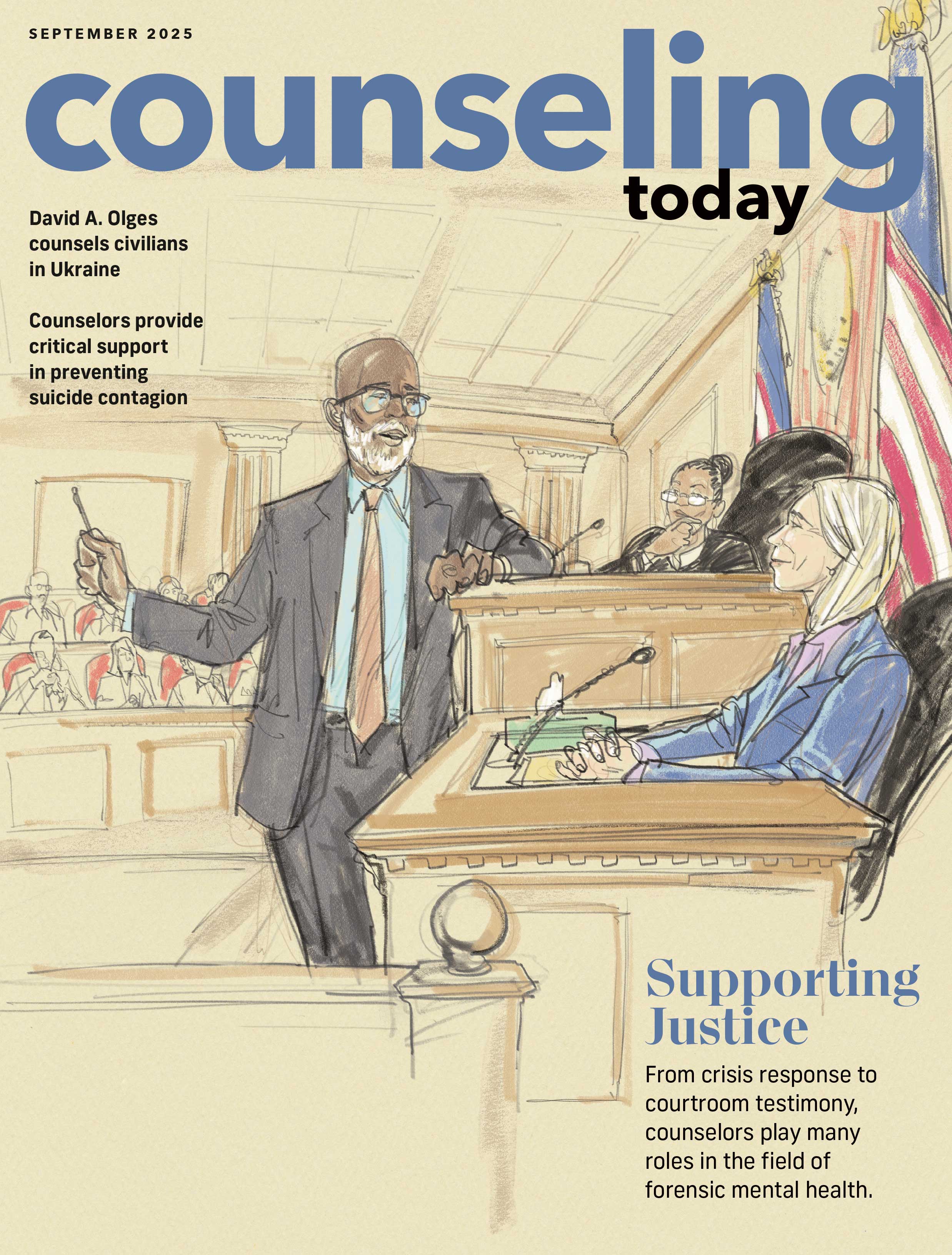
Strength of a Father
Michael Hannon is on a mission to center Black fathers.
Counseling Today Member Blog
By Habibatu Badmus, LPC

Working with clients charged with DWI, DUI or minor assault reveals a wide spectrum of awareness, emotions and readiness for change. Research from the Bureau of Justice Statistics shows 45% to 65% of justice-involved individuals meet criteria for a diagnosable mental health disorder.
Some clients show signs of embarrassment; others seem indifferent. Some have never set foot in a counseling space before. Many don't come humbled — they come unsure, sometimes defensive and often disconnected from the impact of their behaviors.
Many of these individuals have never learned the tools counselors ask them to use such as regulation, reflection and restraint. They may not understand how their impulsivity or fixation on the next high led them to their current circumstances. And it’s not because they don’t care but because their environments never taught them how to stop, how to pause or how to make a different choice.
They Don’t Have the Language
For many, communication itself is a barrier. Not because they don’t want to talk but because they genuinely don’t know how. They weren’t raised to name emotions, to express vulnerability or to ask for help without fear. When we ask questions such as “How are you feeling?” or “What triggered that reaction?” and get a blank stare in response, it isn’t resistance — it’s unfamiliarity.
This absence of emotional vocabulary makes counseling feel foreign and sometimes unsafe. What we see as basic reflection may feel to them like emotional exposure they’ve never had to face. The work, then, begins with creating safety — not just to speak but to learn what to say and how to say it.
Daily Frustration and the Weight of Stigma
For many justice-involved clients, their criminal record walks into the room before they do. People with criminal records may face a reduction in employment opportunities. For example, according to the U.S. Equal Employment Opportunity Commission, people who have been incarcerated are about half as likely to be federally employed compared to those without records. Long before someone says a word, assumptions have been made about who they are, what they value and what they’re capable of.
That kind of stigma isn’t just felt in the counseling room; it follows them everywhere. Stigma is present in the look someone gets at job interviews, the hesitation from landlords, the background check box that closes doors before conversations begin. Over time, these repeated rejections wear people down. Stigma reinforces a belief that no matter how much someone changes, they’ll always be seen for the worst thing they’ve done.
This daily frustration fuels feelings of shame, isolation and hopelessness. And when someone feels alienated from society, it becomes harder to imagine themselves as a part of it, much less as someone who belongs, contributes or succeeds. This is why building hope and restoring identity in counseling are just as important as addressing behavior.
Fear of Change Is Real
There’s a common misconception that justice-involved clients “don’t want better.” Often the opposite is true: They want better but don’t know how to get there. Ultimately, the fear of change is real: Fear of success, fear of leaving behind old identities or friendships, fear of failure and fear of the unknown.
In the mind of a justice-involved client, success might require a new self-image, new rules and new people. For many clients, that's more terrifying than any jail cell. The idea of stepping into a life they’ve never seen modeled can feel deeply disorienting. It’s not just about believing in change — it’s about believing they’re worthy of it.
What Counselors Can Do
Consider the following tips for helping justice-involved clients work through changes:
- Foster Trust: Create a space where judgment doesn’t enter the room. Allow them to come as they are and not who the world assumes them to be.
- Normalize the Learning Curve: Help clients understand that developing emotional regulation and communication skills is a process and not a one-time fix. Validate their effort, not just their outcomes.
- Be Patient with Uncertainty: Silence isn’t always resistance. It’s often hesitation: Can I trust this person? Will I be judged for my truth? Wait with them and don’t rush them.
- Provide Resources and Options: Offer practical, career-focused resources that are realistic for people with records, including vocational training, entrepreneurship programs and reentry resources. Let them know they still have choices.
- Speak to the Potential: Tell them the truth: A percentage of people do make it, and they can be part of that number. One mistake or even several don’t disqualify them from living a meaningful life.
Counseling justice-involved clients is not about pointing out what someone has done wrong. It’s about walking beside them as they figure out who they can still become. When we look past their records, past their silence and past the layers of learned defensiveness, we find people. People who may not know what growth looks like yet but who are slowly beginning to imagine it.
Counselors can help them see a positive and productive version of themselves. Let us be the ones who don’t flinch at their truth but instead meet it with the calm assurance that healing is possible and they’re not alone.
Note: Opinions expressed and statements made in this blog do not necessarily represent the policies or opinions of ACA and its editors.
Online Exclusives
-
 The Myths (and Truths) of Human TraffickingJuly 2025 |By Samantha Cooper, Staff Writer
The Myths (and Truths) of Human TraffickingJuly 2025 |By Samantha Cooper, Staff WriterUnderstanding the reality of human trafficking makes it easier to help the victims.
-
 General Session Recap: Dr. Tommie Mabry on Childhood TraumaMarch 2025 |By Caren Clark
General Session Recap: Dr. Tommie Mabry on Childhood TraumaMarch 2025 |By Caren ClarkTommie Mabry, PhD, discusses the power of intervention as a protective factor for youth with adverse childhood experiences.
-
-and-jeanette-betancourt-(right)ebdb.png?sfvrsn=ffae5bd0_2) General Session Recap: Nourishing Young Children’s Well-BeingMarch 2025 |By Caren Clark
General Session Recap: Nourishing Young Children’s Well-BeingMarch 2025 |By Caren ClarkDay two of the 2025 ACA Conference & Expo featured a discussion of strategies and resources to promote the mental health of children and youth.
Search CT Articles
Sign Up for Updates
Keep up to date on the latest in counseling practice. Sign up to receive email updates from Counseling Today.
CT on YouTube
Download Recent Issues
ACA members receive access to past full issues of Counseling Today. Log in to download copies from the archive.












